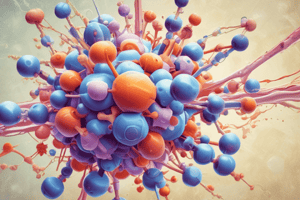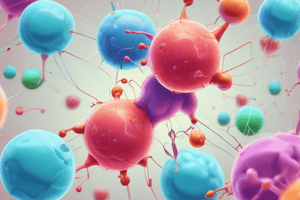Podcast
Questions and Answers
Which type of bonds attach the light chains to the heavy chains in an antibody molecule?
Which type of bonds attach the light chains to the heavy chains in an antibody molecule?
- Ionic bonds
- Covalent bonds (correct)
- Van der Waals forces
- Hydrogen bonds
What is the composition of an antibody molecule?
What is the composition of an antibody molecule?
- One heavy chain and one light chain
- One heavy chain and two light chains
- Two heavy chains and two light chains (correct)
- Two heavy chains and one light chain
What is the structure of an immunoglobulin (Ig) domain?
What is the structure of an immunoglobulin (Ig) domain?
- Two layers of β-pleated sheet (correct)
- Two layers of α-helical loops
- A single layer of β-pleated sheet
- A single layer of α-helical loops
Which type of B cell progeny may produce antibodies of other heavy-chain classes?
Which type of B cell progeny may produce antibodies of other heavy-chain classes?
Which type of light chain remains fixed throughout the life of each B cell clone?
Which type of light chain remains fixed throughout the life of each B cell clone?
Which function do light chains NOT participate in, except binding and neutralizing microbes and toxins?
Which function do light chains NOT participate in, except binding and neutralizing microbes and toxins?
Which region of the antibody molecule contributes most to antigen binding?
Which region of the antibody molecule contributes most to antigen binding?
Which region of the antibody molecule tends to crystallize in solution?
Which region of the antibody molecule tends to crystallize in solution?
Which region of the antibody molecule allows the two antigen-binding Fab regions to move independently of each other?
Which region of the antibody molecule allows the two antigen-binding Fab regions to move independently of each other?
Which isotype of antibody has five subtypes?
Which isotype of antibody has five subtypes?
Flashcards are hidden until you start studying
Study Notes
Antibody Molecule Structure
- Disulfide bonds attach the light chains to the heavy chains in an antibody molecule.
- An antibody molecule is composed of two heavy chains and two light chains.
Immunoglobulin (Ig) Domain Structure
- The structure of an immunoglobulin (Ig) domain consists of a β-barrel with a hydrophobic core and a β-sheet framework.
B Cell Progeny and Antibody Production
- Plasma cells, a type of B cell progeny, may produce antibodies of other heavy-chain classes.
Light Chain Composition and Function
- The κ (kappa) or λ (lambda) light chain remains fixed throughout the life of each B cell clone.
- Light chains participate in binding and neutralizing microbes and toxins, but do not participate in activation of the complement system.
Antibody Molecule Regions and Functions
- The variable region (Fv) of the antibody molecule contributes most to antigen binding.
- The crystallizable fragment (Fc) region tends to crystallize in solution.
- The hinge region of the antibody molecule allows the two antigen-binding Fab regions to move independently of each other.
Antibody Isotypes and Subtypes
- The IgM isotype of antibody has five subtypes.
Studying That Suits You
Use AI to generate personalized quizzes and flashcards to suit your learning preferences.




